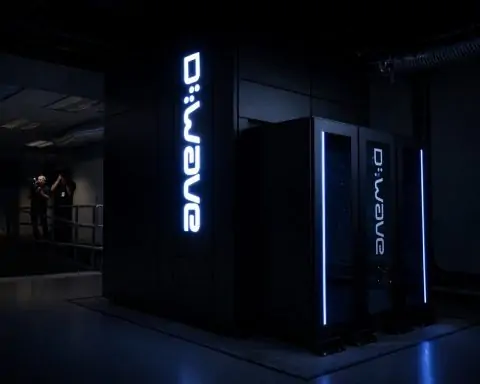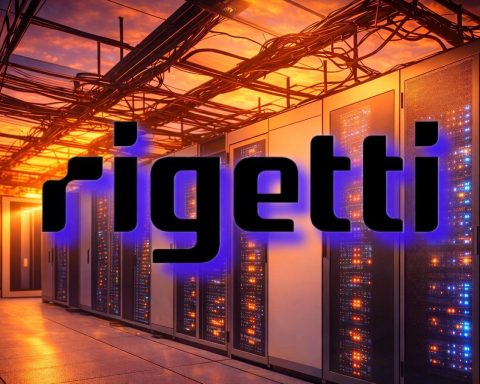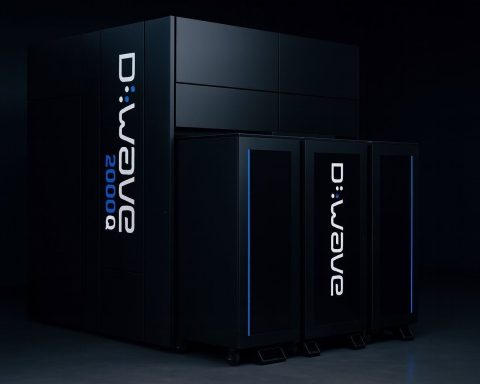- Fujitsu announced it has begun developing a superconducting quantum computer exceeding 10,000 qubits, targeted for completion in 2030, using a new STAR early fault-tolerant architecture with 250 logical qubits as part of a Japanese government-backed project to industrialize quantum technology.
- IonQ and Oak Ridge National Laboratory demonstrated a quantum-classical solution for power grid optimization by using IonQ’s 36-qubit Forte system to solve a Unit Commitment problem as part of the DOE GRID-Q program.
- Rigetti Computing reported 99.5% two-qubit gate fidelity on its 36-qubit superconducting processor built from four 9-qubit chiplets, announcing an August 15 launch and a plan to exceed 100 qubits by year-end.
- Quantinuum opened an R&D hub in Albuquerque, New Mexico focused on photonics control hardware for trapped-ion qubits, hiring at least seven staff by year’s end.
- A Cambridge and Université Paris-Saclay team reported a carbon-based molecule with two spin radical units that directly couples an electron’s spin to the light it emits, with orange fluorescence for triplet and near-infrared for singlet.
- French startup C12 Quantum Electronics and École Normale Supérieure achieved a record ~1.3 microseconds electron-spin qubit coherence in a carbon nanotube double quantum dot coupled to a microwave cavity at 0.3 K.
- The National Quantum Cybersecurity Migration Strategy Act was introduced on August 1 by two U.S. senators to require a coordinated roadmap to post-quantum cryptography and pilot quantum-resistant encryption in critical infrastructure by 2027.
- Karnataka’s government in India announced the Karnataka Quantum Mission with ₹1,000 crore (~$114 million) to help create a $20 billion quantum economy by 2035, including 1,000-qubit targets around 2030 and 150 PhD scholarships per year, with the first domestically built commercial quantum computer already operational in Bengaluru.
- Japan unveiled a ¥50 billion JPY (~$335 million) quantum industrialization package led by METI to back 10+ companies, including Fujitsu and KDDI, and to create a Quantum Collaboration Center nicknamed G-QuAT as part of 2025’s push to industrialize quantum tech.
- SoftBank Vision Fund 2 invested in Israeli quantum software startup Classiq as part of a Series C round to accelerate its enterprise quantum algorithm design platform and expand globally.
Over the weekend of August 2–3, 2025, the quantum computing world saw a flurry of major developments. Global tech companies unveiled ambitious plans and technical milestones, researchers reported record-breaking breakthroughs, governments rolled out new quantum initiatives, big investors placed fresh bets, and experts weighed in on the hype versus reality. Below is an in-depth roundup organized by category, covering all the bombshell announcements, breakthroughs, partnerships, financial moves, policy updates, and expert commentary from the past two days.
Industry Moves
- Fujitsu’s 10,000+ Qubit Quest: Kicking off the month, Fujitsu announced it has begun developing a superconducting quantum computer exceeding 10,000 qubits, targeted for completion in 2030 [1]. The planned system will employ Fujitsu’s new “STAR” early fault-tolerant architecture with 250 logical qubits, and is part of a Japanese government-backed project to industrialize quantum technology [2]. “By realizing 250 logical qubits in fiscal 2030 and 1,000 logical qubits in fiscal 2035, Fujitsu is committed to leading the path forward globally in the field of quantum computing,” said Fujitsu CTO Vivek Mahajan [3], highlighting the company’s roadmap to combine superconducting circuits with diamond-spin qubits in the next decade.
- IonQ & ORNL Optimize the Power Grid:IonQ, in partnership with Oak Ridge National Laboratory (ORNL), demonstrated a quantum-classical solution for power grid optimization. Using IonQ’s 36-qubit Forte quantum system integrated with classical computing, the team solved a complex Unit Commitment problem (scheduling power generators to meet demand) that grows intractable for classical methods [4] [5]. “This demonstration marks a significant milestone in applying quantum computing to real-world energy challenges,” said IonQ CEO Niccolo de Masi, adding that as IonQ’s machines scale to “thousands and millions of qubits,” they expect to tackle grid problems at a scope beyond classical reach [6]. ORNL’s project lead Suman Debnath noted the case study proved feasible on today’s device and that as the hardware improves, researchers will test for true quantum advantage in grid operations [7]. This achievement, part of the U.S. Department of Energy’s multi-year GRID-Q program, positions energy grid management as a promising early use-case for quantum optimization.
- Rigetti Hits Record 99.5% Fidelity: Quantum hardware startup Rigetti Computing announced a major performance breakthrough, achieving 99.5% two-qubit gate fidelity on its newest 36-qubit superconducting processor [8]. This marks a 2× reduction in error rate from Rigetti’s previous 84-qubit system and inches closer to the error thresholds required for quantum error correction. The 36-qubit device is composed of four “chiplets” (9 qubits each) tiled together – a modular approach that paves the way to a 100+ qubit chiplet-based processor by late 2025 (with the same 99.5% fidelity target) [9] [10]. “By leveraging well-known techniques from the semiconductor industry, we’ve developed proprietary technology that we believe is critical to enable scaling to higher qubit count systems,” explained Rigetti CEO Dr. Subodh Kulkarni [11]. Rigetti plans to launch the new 36-qubit machine on August 15 and remains on track to release a >100-qubit system by year’s end [12]. The technical leap was met with enthusiasm on Wall Street – Rigetti’s stock price jumped nearly 10% on the news, as analysts hailed 99.5% fidelity as a potential “gold standard” for unlocking commercial quantum applications [13].
- Quantinuum Expands to the Southwest:Quantinuum, the world’s largest integrated quantum computing company (formed via Honeywell Quantum and Cambridge Quantum), announced it will open a new R&D hub in Albuquerque, New Mexico [14]. The facility will be converted into a quantum optics lab focused initially on photonics control hardware for Quantinuum’s trapped-ion systems – essentially the lasers and optical components that manipulate ion qubits [15] [16]. At least seven staff will be hired by year’s end as the site ramps up, and the work will integrate into Quantinuum’s full-stack operations spanning hardware, software, and cybersecurity [17] [18]. “We’re there to develop R&D for our hardware, but we also bring with us the connections to a full-stack quantum computing company…adding to the richness of our presence in New Mexico,” said Jenni Strabley, a Quantinuum general manager, on the move to Albuquerque [19]. This marks one of the first major quantum hardware outposts in New Mexico – a state positioning itself as an emerging quantum technology hub – and reflects a broader industry trend of expanding into new regions (the area offers proximity to federal labs and a photonics talent base) as quantum firms scale up nationally.
Academic Breakthroughs
- Molecule Links Spin to Light: A joint team from the University of Cambridge (UK) and Université Paris-Saclay (France) unveiled a novel carbon-based molecular material that directly couples an electron’s spin state with the light it emits. In a paper published in Nature Chemistry, the researchers engineered an organic molecule containing two “spin radical” units (each with an unpaired electron) connected as a diradical [20] [21]. The two electron spins can be aligned in a triplet state or a singlet state, and remarkably, the molecule’s fluorescence changes color depending on the spin state. When the spins align in the triplet configuration, the molecule emits visible orange light; in the singlet (opposite spins) configuration, it emits near-infrared light [22]. “This allows you to very easily detect and know the quantum states of the molecule just by looking at the colour,” explained Rituparno Chowdhury, a Cambridge PhD student and first author [23]. Because the color provides a direct optical readout of the spin, this molecular approach offers a much simpler and cheaper way to sense quantum information compared to today’s exotic materials (like NV-diamond defects) [24] [25]. The discovery opens a new path toward low-cost, tunable quantum sensors and devices where quantum states can be controlled and read out via light in an organic medium.
- Record-Long Qubit Coherence in Carbon: French researchers at startup C12 Quantum Electronics and the École Normale Supérieure demonstrated a record-setting coherence time of ~1.3 microseconds for an electron spin qubit in a carbon-based quantum circuit [26]. This is about 100× longer than previous carbon nanotube qubits and even 10× longer than typical silicon spin qubits under similar conditions [27]. The team’s experiment, published in Nature Communications, used a suspended carbon nanotube double quantum dot integrated in a microwave cavity (a circuit QED setup) at 0.3 K temperature [28] [29]. By eliminating disorder (using a clean, pure carbon-12 nanotube with no substrate) and coupling the system to cavity photons for control instead of any external magnetic field, they greatly suppressed noise and achieved unprecedented stability. The nanotube qubit maintained coherent quantum oscillations for microsecond durations, which revives interest in carbon nanotubes as a promising platform for scalable quantum processors [30]. Achieving silicon-beating coherence in carbon suggests that with further refinement (e.g. leveraging carbon’s lack of nuclear spin), carbon-based qubits could become serious contenders in the race for longer-lived, high-fidelity quantum bits [31] [32]. The result sets a new benchmark for hybrid spin-photon devices and showcases an approach to quantum hardware that operates at relatively higher temperature (300 mK) without sacrificing coherence.
Regulatory and Policy Updates
- U.S. Pushes for Quantum-Proof Encryption: In Washington, two U.S. senators introduced the National Quantum Cybersecurity Migration Strategy Act on August 1, a bipartisan bill to ensure federal agencies prepare for the day quantum computers can crack current encryption [33] [34]. The proposed law directs the White House Office of Science and Technology Policy to develop a coordinated roadmap for migrating government systems to post-quantum cryptography and mandates pilot programs to deploy quantum-resistant encryption in critical infrastructure sectors by 2027 [35] [36]. “It’s critical that the federal government be prepared for any threat posed by quantum computing technology, especially when it concerns our national security,” said Senator Gary Peters, who co-sponsored the bill, underscoring the urgency of proactive migration to quantum-safe solutions [37]. The effort builds on the 2018 National Quantum Initiative and 2022 Quantum Cybersecurity Preparedness Act, reflecting growing concern in Washington about the looming “Q-day” when sufficiently powerful quantum machines could jeopardize classical encryption. By starting the transition now – even though code-breaking quantum computers are still years away – lawmakers aim to avoid a last-minute scramble to secure sensitive data in the future [38] [39].
- India (Karnataka) Launches $20 B Quantum Mission: In India, the state government of Karnataka (home to tech hub Bengaluru) announced an ambitious ₹1,000 crore (~$114 million) Karnataka Quantum Mission as a blueprint to create a $20 billion “quantum economy” by 2035 [40] [41]. Unveiled by Chief Minister Siddaramaiah at the Quantum India 2025 summit in Bengaluru, the plan lays out five pillars: quantum workforce development (including rolling out quantum curricula in colleges and 150 PhD scholarships per year), R&D targets (a homegrown 1,000-qubit processor by around 2030), new infrastructure (India’s first Quantum Hardware Park with a chip fab line by year-end), industry support (a state-backed Quantum Venture Fund for 100+ startups), and international partnerships [42] [43]. “By 2035, we aim to create 10,000 high-skilled jobs and establish Karnataka as the quantum capital of Asia,” the Chief Minister said, highlighting the state’s intent to lead India’s quantum revolution [44]. Notably, officials revealed that India’s first domestically built commercial quantum computer is already operational in Bengaluru, an early milestone that the new mission will build upon [45]. Karnataka’s regional initiative complements India’s National Quantum Mission (launched by the central government last year with ₹6,000 crore funding) by leveraging local talent clusters in Bengaluru and fostering public-private collaboration. The bold state-level investment underscores how emerging tech economies are betting big on quantum technologies to drive future growth and strategic advantage.
- Japan’s ¥50 B Tech Boost: In a move paralleling Fujitsu’s corporate announcement, the Japanese government unveiled a ¥50 billion JPY (~$335 million) package to turbocharge Japan’s domestic quantum industry [46] [47]. Spearheaded by the Ministry of Economy, Trade and Industry (METI), the initiative will support 10+ companies and startups working across quantum hardware, software, and even a home-grown quantum operating system [48] [49]. Major players like Fujitsu and telecom KDDI are involved alongside startups (for example, OptQC in photonic qubits and Jij for middleware) [50] [51]. Officials have dubbed 2025 as Japan’s “first year of quantum industrialization,” signaling a national strategy to move from lab research into real-world deployment and commercialization [52]. A key goal of the program is to seize advantage in the quantum software and OS layer, an area where no global standard has yet emerged, so that Japan can set de facto standards (much as it once did in consumer electronics). The government will also establish new infrastructure including a Quantum Collaboration Center (nicknamed “G-QuAT”) to facilitate industry-academia cooperation and is emphasizing public–private partnerships to ensure research breakthroughs translate into market leadership [53] [54]. This hefty state investment, aligned with Fujitsu’s 10,000-qubit project, shows Japan’s determination not to fall behind the U.S. and China in the coming quantum tech race [55] [56]. Japan now joins a growing list of nations pouring substantial funds into quantum technology as a strategic priority for economic and national security.
Financial and Investment Moves
- SoftBank Bets on Quantum Software: In a notable vote of confidence, SoftBank’s Vision Fund 2 announced a strategic investment in Israeli quantum software startup Classiq as part of an expanded Series C funding round [57] [58]. SoftBank is injecting capital (alongside Italy’s CDP Venture Capital) to help Classiq accelerate development of its enterprise-level quantum algorithm design platform and expand globally in sectors like finance, energy, and pharma [59] [60]. The investment followed an in-depth technical vetting by SoftBank’s R&D team, which was impressed by Classiq’s ability to generate high-performance quantum circuits optimized for today’s hardware [61]. “SoftBank and CDP Venture Capital bring bold, long-term perspectives to deep tech,” said Classiq CEO Nir Minerbi, “Their support reflects a strong belief in Classiq’s mission to unlock quantum computing for real-world applications and to shape the future of this transformative technology.” [62] This marks one of the larger quantum software funding deals of the year and underscores continued investor enthusiasm for companies that can bridge the gap between quantum algorithms and practical use cases.
- China’s SpinQ Raises Big Round: In China, SpinQ Technology, known for producing compact desktop quantum computers, secured “hundreds of millions” of yuan in a Series B funding round to fuel its technological upgrades and commercial expansion [63]. Announced in late July, this large financing (from undisclosed investors) will support Shenzhen-based SpinQ’s efforts to develop more powerful table-top quantum hardware and broaden adoption of its educational and business-oriented quantum systems. The raise points to growing global investor appetite for quantum hardware ventures – not just in North America and Europe, but across Asia as well. SpinQ’s successful round comes on the heels of several other quantum startup fundings this summer, adding momentum to the sector’s capital influx. Overall, despite volatile public markets for some quantum stocks, private investment in quantum technologies remains strong in 2025, with both deep-tech venture funds and government-affiliated funds (like SoftBank and China’s state-backed capital) making big bets on the future of quantum computing.
Expert Commentary and Reactions
- Big Tech CEO Bullish on Quantum: Even as generative AI grabs headlines, tech leaders are already eyeing quantum computing as the next game-changer. On Microsoft’s July 31 earnings call, CEO Satya Nadella took a moment to highlight the company’s long-term bet on quantum, declaring that “the next big accelerator in the cloud will be quantum” [64]. Nadella noted that while quantum isn’t contributing to revenue yet, Microsoft is investing on a “decade-long arc” of innovation. In fact, earlier in July Microsoft announced the world’s first operational Level-2 quantum computer – a prototype system with basic error correction for a logical qubit – deployed in partnership with startup Atom Computing [65]. “I’m excited about our progress,” Nadella said, expressing confidence that over time quantum processors will become a core cloud workload alongside AI and classical computing [66]. His high-profile endorsement gave a jolt of optimism to the industry, signaling that cloud giants see quantum computing as the next frontier once scalability and error-correction challenges are overcome.
- Schneier Throws a Reality Check: Amid the wave of quantum optimism, renowned security expert Bruce Schneier offered a healthy dose of skepticism. In a widely-read blog post, Schneier cautioned that some touted quantum breakthroughs aren’t as impressive as they sound – essentially calling out instances of “quantum hype.” He pointed to new research showing how scientists sometimes “cheat” on quantum advantage benchmarks by choosing toy problems that are unnaturally easy for quantum algorithms to solve (for example, factoring specially crafted numbers that even a vintage classical computer could factor) [67] [68]. Schneier’s broader point: truly useful, general-purpose quantum computers remain a distant goal. “We don’t know if [building one] is ‘land a person on the surface of the moon’ hard, or ‘landing a person on the surface of the sun’ hard,” he quipped, noting both are “hard, but very different” levels of difficulty [69]. He does not expect quantum machines to crack standard RSA encryption anytime soon, and reminded readers that enormous engineering obstacles lie between today’s prototypes and a at-scale, fault-tolerant quantum computer [70]. Schneier even mused about practical constraints often overlooked in the excitement – for instance, today’s quantum hardware relies on liquid helium cooling, a scarce resource. “Can we afford the helium to make general quantum computing viable?” he challenged, underscoring that scaling up quantum tech will require solving not just theoretical problems but gritty engineering and materials issues as well [71]. His sober commentary serves as a reality check for the field: even as investments pour in and milestones are celebrated, experts urge caution against overhyping progress and recommend maintaining realism about the long road ahead toward truly transformative quantum computing applications.
Sources: The information above was drawn from publicly available sources dated August 1–3, 2025 (with a few late-July items for context). Key references include official press releases (e.g. Fujitsu [72], IonQ [73], Rigetti [74], Classiq【44†L117-L125}), news articles and industry reports (The Quantum Insider, SecurityWeek, Indian Express, etc.), and expert blogs/transcripts (Microsoft earnings call【41†L263-L271】, Schneier on Security [75]). These provide a comprehensive roundup of the quantum computing landscape as it stood in the first days of August 2025. All direct quotations are credited to their original speakers and sources.
References
1. global.fujitsu, 2. global.fujitsu, 3. global.fujitsu, 4. investors.ionq.com, 5. investors.ionq.com, 6. investors.ionq.com, 7. investors.ionq.com, 8. www.globenewswire.com, 9. www.globenewswire.com, 10. www.globenewswire.com, 11. www.globenewswire.com, 12. www.globenewswire.com, 13. ts2.tech, 14. thequantuminsider.com, 15. thequantuminsider.com, 16. thequantuminsider.com, 17. thequantuminsider.com, 18. thequantuminsider.com, 19. thequantuminsider.com, 20. www.phy.cam.ac.uk, 21. www.phy.cam.ac.uk, 22. www.phy.cam.ac.uk, 23. www.phy.cam.ac.uk, 24. www.phy.cam.ac.uk, 25. www.phy.cam.ac.uk, 26. thequantuminsider.com, 27. thequantuminsider.com, 28. thequantuminsider.com, 29. thequantuminsider.com, 30. thequantuminsider.com, 31. thequantuminsider.com, 32. thequantuminsider.com, 33. www.securityweek.com, 34. www.securityweek.com, 35. www.securityweek.com, 36. www.securityweek.com, 37. www.securityweek.com, 38. www.securityweek.com, 39. www.securityweek.com, 40. indianexpress.com, 41. indianexpress.com, 42. ts2.tech, 43. ts2.tech, 44. indianexpress.com, 45. ts2.tech, 46. ts2.tech, 47. thequantuminsider.com, 48. thequantuminsider.com, 49. thequantuminsider.com, 50. thequantuminsider.com, 51. thequantuminsider.com, 52. ts2.tech, 53. ts2.tech, 54. thequantuminsider.com, 55. ts2.tech, 56. ts2.tech, 57. thequantuminsider.com, 58. thequantuminsider.com, 59. thequantuminsider.com, 60. thequantuminsider.com, 61. thequantuminsider.com, 62. thequantuminsider.com, 63. thequantuminsider.com, 64. www.microsoft.com, 65. www.microsoft.com, 66. www.microsoft.com, 67. www.schneier.com, 68. www.schneier.com, 69. www.schneier.com, 70. www.schneier.com, 71. www.schneier.com, 72. global.fujitsu, 73. investors.ionq.com, 74. www.globenewswire.com, 75. www.schneier.com









